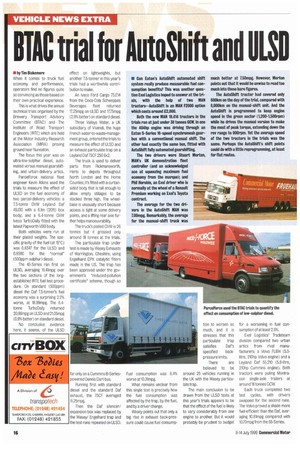BTAC trial for AutoShift and Ma II by Tim Blakemore
Page 18

If you've noticed an error in this article please click here to report it so we can fix it.
When it comes to truck fuel economy and performance, operators find no figures quite so convincing as those based on their own practical experience.
This is what drives the annual technical trials organised by the Brewery Transport Advisory Committee (BTAC) and The Institute of Road Transport Engineers (IRTE) which are held at the Motor Industry Research Association (MIRA) proving ground near Nuneaton.
The focus this year was on ultra-low-sulphur diesel, automated versus manual gearshifting, and urban-delivery artics.
Parcelforce national fleet engineer Kevin Atkins used the trials to measure the effect of ULSD on the fuel economy of two parcel-delivery vehicles: a 7.5-tonne GVW Leyland Daf 45.130 with a 6:Im (20ft) box body; and a 6.4-tonne GVW lveco TurboDaily fitted with the latest Papworth VBB body.
Both vehicles were run at their plated weights. The specific gravity of the fuel (at 15°C) was 0.8347 for the ULSD and 0.8590 for the "normal" ( 500pprn-sulphur) diesel.
The 45-Series ran first on ULSD, averaging 19.41mpg over the two sections of the longestablished IRTE fuel test procedure. On standard (500ppm) diesel the Daf 75-tonner's fuel economy was a surprising 2.2% worse, at 18.99mpg. The 6.4tonne TurboDaily returned 20.86mpg on ULSD and 21.05mpg (119% better) on standard diesel.
No conclusive evidence here, it seems, of the ULSD effect on lightweights, but another 7.5-tanner in this year's trials had a worthwhile contribution to make.
An Iveco Ford Cargo 75.E14 from the Coca-Cola Schweppes Beverages fleet returned 17.25mpg on ULSD and 17.75mpg (2.9% better) on standard diesel.
Three Valleys Water, a UK subsidiary of Vivendi, the huge French water-to-waste-management group, entered the trials to measure the effect of ULSD and an exhaust particulate trap on a Leyland Daf 75CF 250 5x2.
The truck is used to deliver parts from Rickmansworth, Herts to depots throughout North London and the Home Counties; it's fitted with a curtainsided body that is tall enough to allow empty stillages to be stacked three high. The wheelbase is unusually short because access is tight at some delivery points, and a lifting rear axle further helps manoeuvrability The truck's plated GVW is 26 tonnes but it grossed only around 18 tonnes at the trials.
The particulate trap under test is made by Wasey Exhausts of Warrington, Cheshire, using Engelhard DPX catalytic fitters made in the US. The trap has been approved under the government's "reduced-pollution certificate" scheme, though so far only on a Cummins B-Seriespowered Dennis Dart bus.
Running first with standard diesel and the standard Daf exhaust, the 75CF averaged 11.25mpg.
Then the Daf silencer/ expansion box was replaced by the Wasey/ Engelhard trap and the test runs repeated on ULSD. Fuel consumption was 8.4% worse at 10.31mpg.
What remains unclear from this single test is precisely how the fuel consumption was affected by the trap, by the fuel, and by a driver change.
Wasey points out that only a big rise in exhaust back-pressure could cause fuel consume
tion to worsen so much, and it is stresses that this particulate trap satisfies Oaf's specified back pressure limits.
There are believed to be around 25 vehicles running in the UK with the Wasey particulate trap.
The main conclusion to be drawn from the ULSD tests at this year's trials appears to be that the effect of the fuel is likely to vary considerably from one engine to another. But it would probably be prudent to budget for a worsening In fuel consumption of at least 2.5%.
Exel Logistics' Tradeteam division compared two urban artics from rival manufacturers: a Volvo FL614 (5.5litre, 210hp Volvo engine) and a Leyland Daf 55.210 (5.9-litre, 210hp Cummins engine). Both tractors were pulling Montracon single-axle trailers at around 18 tonnes GCW.
Each truck completed two test cycles, with drivers swapped for the second runs. The Volvo proved a shade more fuel-efficient than the Daf, averaging 10,81mpg compared with 10.70mpg from the 55-Series.








































































































